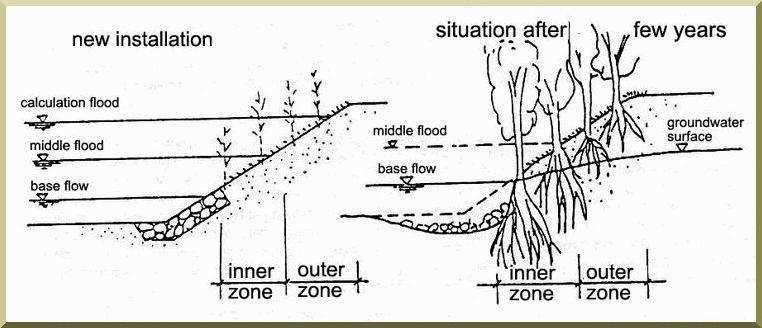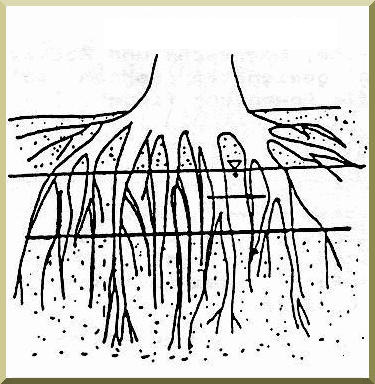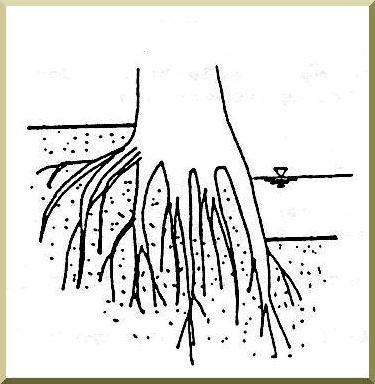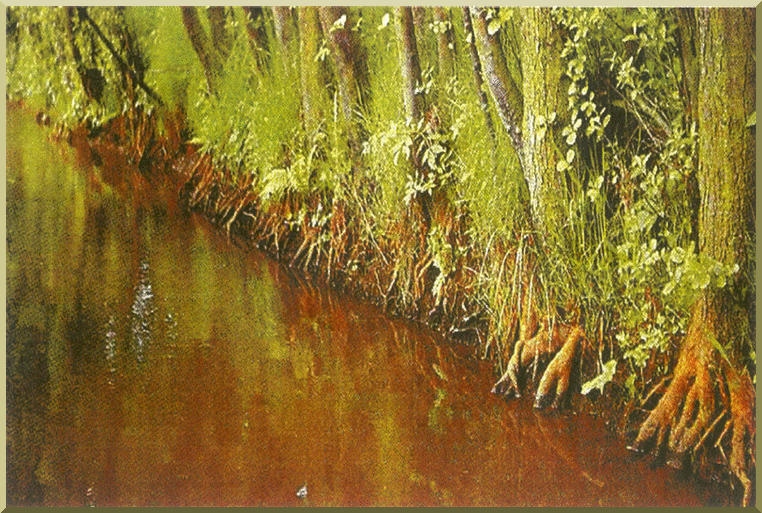|
| |
|
Design velocities for vegetated and gabion-lined channels
Victor M. Ponce and Andreas KochJuly 2003
|
|
1. INTRODUCTION
The velocity of flow in watercourses has a direct relation to roughness and bank stability.
The roughness decreases as the velocity increases when all other variables are held constant. When the velocity increases, the shear stress
increases on the bed and bank material. This increases the rate of erosion and sediment transport.
There are several ways to protect the channel against bed and bank erosion.
The banks can be protected directly by using different types of sheeting.
There are different kinds of concrete and other artificial lining
devices available (e.g., crushed stone and gabions).
Natural solutions for bank stabilization include the lining
of channels with lawns, vegetated mattresses and bundles of wood.
The advantages and disadvantages of bank stabilization using vegetated and gabion-lined channels are presented below.
|
Table 1. Comparison between vegetated and gabion-lined channels
|
| Vegetated channels |
Gabion-lined channels |
| Advantages |
Disadvantages |
Advantages |
Disadvantages |
Higher infiltration and exfiltration
Excellent habitat function
Sizable reduction in flow velocity
Aesthetically very pleasing
|
|
High stability
Moderate infiltration and exfiltration
Immediate protection after installation
Moderate reduction in flow velocity
|
|
2. ECOLOGICAL DESIGN
Gabions consist of mesh baskets filled with small riprap. A gabion structure can consist of several baskets
(Fig. 1)
Fig. 1 Layout and dimensions of gabion boxes and mattresses.
Since the riprap is enclosed with wire mesh, it has high stability against erosion.
Vegetation can be planted and is able to grow between the gabions layers (Fig. 2).
Fig. 2 Gabion boxes with woody vegetation.
Planting vegetation in gabions provides habitat, decreases the flow velocity during storm events and increases their aesthetic appeal.
More details about gabions are given in manningsn_hydroecological.html.
In bank stabilization using natural vegetation, attention must be paid to the
temporal wetting zones to guarantee habitat sustainability.
The temporal wetting zones are: - A. Permanently wetted,
- B. Intermittently wetted,
- C. Event-wetted, or floodplain.
A. Permanently wetted zone:
Wattle and fascines are used in various types of assemblies.
Wattle (Fig. 3):
Fig. 3 Wattle of branches.
Staked 30-50 cm into the ground.
Stakes are braided with flexible strong brushwood.
Height of assembly 30-80 cm.
Serves as a temporary solution.
B. Intermittently wetted zone:
Cattails are placed in the intermittently wetted zone.
C. Event-wetted, or floodplain zone:
For successful bank stabilization of the floodplain zone, the area is engineered by ecological means and the roots will take hold. The following natural building materials are used:
Finished lawn:
Lawn pieces:
Square turf sods with a edge length of 25-30 cm and a thickness of 3-8 cm.
Imported from other locations.
The installation can take place as flat lawns or as head lawns.
Lawns are laid flat or in stacks.
Flat lawns use bank slopes of 1.5:1-2:1; 3:1 is rarely used (Fig. 6).
Fig. 6 Flat lawns.
Areas with high shear stress should be anchored with stakes of length 20-30 cm.
Stacked lawns use bank slopes of 0.75:1 for flowing water bodies; at walls use slopes of 0.3:1-1:1.
The lawns are stacked as shown in Fig. 7.
Fig. 7 Stacked lawns.
- Lawn rolls (Fig. 8):
The principle is the same as that of flat lawns.
They can be handled over larger surfaces.
They can be grown beforehand on special surfaces.
Fig. 8 Lawn roll.
Lawn seeds:
They are disseminated by wet or dry means (Fig. 9).
Fig. 9 Lawn seeding.
Young seedlings can be protected against removal by means of fiber mattresses or by mixing with a biodegradable adhesive during seeding (Fig. 10).
Fig. 10 Fiber mattress for protection of seeds.
Vegetative bank stabilization (Fig. 11):
Consists of individual components of 2 x 6 m and a thickness of 0.2 m.
The materials are a mixture of gravel, plastic mesh, biodegradable geotextiles, and endemic riparian vegetation.
The building materials are combined and spread in layers.
Can withstand large shear stresses.
Fig. 11 Vegetative bank stabilization.
Wood parts:
Collect staking woody debris during the winter.
Assemble these stakes in any of the following forms:

| Fig. 14 (a) Bank protection with trees and shrubs.
|
|

| Fig. 14 (b) Longitudinal view.
|
|

|

| Fig. 14 (d) Completed bank protection with trees and shrubs.
|
|
3. HYDRAULIC DESIGN
Design parameters
The critical velocity vc and the critical shear stress τc are used in the analysis of the stability of the bottom and the banks of rivers against erosion.
Critical velocity
The stability can be determined by comparing the actual velocity to the maximum allowable velocity or critical velocity vc based on the bed and bank material. The Manning equation can be used:
V = (1/n) R 2/3 S 1/2
in which is v = velocity (m/s), n = Manning's n, R = hydraulic radius (m) and S = slope (m/m).
The critical velocity must be determined by experiments or empirically derived from information in the literature. The critical velocity is that at which erosion of the bed and/or bank material begins. The criterion for stability is:
v < vc
Typical values of critical velocity are shown in Table 2.
|
Table 2. Typical values of critical velocitiy and shear stress
|
| Material |
Critical velocity |
Critical shear stress |
| (m/s) |
(N/m2) |
| Lawn (short-time loaded) |
1.8 |
20-30 |
| Lawn (long-time loaded) |
1.5 |
15-18 |
| Fascine sausage |
2.5-3.0 |
60-70 |
| Fascine roll |
3.0-3.5 |
100-150 |
| Weighted fascine |
2.5-3.0 |
60-100 |
| Brush mattress |
2.5-3.5 |
150-300 |
| Live staking in rip rap |
|
> 140 |
| Willows/alder |
|
80-140 |
| Gabions |
1.8-6.7 |
80-140 |
Critical shear stress
The critical shear stress τc is a measure of the stability of the bed and banks of a river against erosion. The bottom shear stress can be calculated as follows:
τo = γ R S
in which is τo = the bottom shear stress (N/m2), γ = specific weight of water (N/m3), R = hydraulic radius (m) and S = slope (m/m). For wide channels, i.e., those with a top width T ≥ 10 R, the flow depth h is substituted for R:
τo = γ h S
The critical shear stress τc must be determined by experiments or empirically derived from information in the literature. The critical shear stress τc is that at which erosion of the bed and/or bank material begins. The criterion for stability is:
τ < τc
Typical values of critical shear stress are shown in Table 2.
Manning's n
The variety of vegetation cover available in nature implies that there is also a variety of resistance to flow. Flow resistance is dependent on whether vegetation is completely or partially submerged. The controlling factor is the height of the canopy in relation to the water depth. The three general cases are (Fig. 15):
A. Short vegetation, B. Average vegetation, C. Tall vegetation.
A. Short Vegetation is that which is short in relation to the flow depth, its height being on the same scale as the absolute roughness. The velocity distribution in the cross section resembles that due to absolute roughness.
B. Average Vegetation occurs when the plant height is, on the average, the same as the flow depth. It varies between full and partial submersion. The behavior of the resistance to flow demands a special attention to the flow conditions. This is because average vegetation is susceptible to forceful submission (i.e., tilting) when the stream power overcomes the static resistance of the stems. There is a definite relationship between vegetative resistance and the ratio of plant height to flow depth.
C. Tall Vegetation, is that which is tall in relation to the flow depth. This definition excludes plants that bend such that their height is decreased below the water surface.
Fig. 15 (a) Short, (b) Average, and (c) Tall vegetation.
|
Table 3. Roughness coefficient
|
| Surface structure |
k |
KSt |
n |
| (m) |
(m1/3/s) |
[Fig. 16] |
| Lawn |
0.06 |
40 |
0.025 |
| Grass; field without cover |
0.2 |
30 |
0.033 |
| Grassland; rocky forest soil |
0.25 |
25 |
0.040 |
| Grass with shrubs |
0.3 |
24 |
0.042 |
| Herbaceous vegetation |
0.4 |
22 |
0.045 |
| Field with arable crop |
0.6 |
21 |
0.048 |
| Irregular flood plains |
0.8 |
15 |
0.067 |
| Highly irregular flood plains |
1 |
12 |
0.083 |
Fig. 16 (a) Irregular flood plains
(n = 0.055-0.083).
Fig. 16 (b) Herbaceous flood plains
(n = 0.041-0.050).
Fig. 16 (c) Grassland flood plains
(n = 0.028-0.040).
Fig. 16 (d) Grassland flood plains
(n = 0.028-0.040).
For conceptually based calculations, the Darcy-Weisbach formula can be used:
v = (1/ f 1/2) (8 g R S) 1/2
with
f = [(4 Ap,i ) / ( ax ay )] cw,i
for nearly horizontal flood areas, and
f = [(4 Ap,i cos α) / ( ax ay )] cw,i
for hillslope flood areas, with
Ap,i = hi dm,i
The geometric characterization and the equivalent diameter are shown in Fig. 17 and Fig. 18.
Fig. 17 Geometric characterization of tree population density.
Fig. 18 Determination of the equivalent diameter.
For an individual specimen, the coefficient of resistance cw,i is equal to that of a circular cylinder for which cw = 1.2.
For groups of trees or bushes, the following formulas can be used:
f = [(4 Ap ) / ( ax ay )] cw,r
f = [(4 Ap cos α) / ( ax ay )] cw,r
with cw,r between 0.6 and 2.4, with mean value cw,r = 1.5.
4. RIPARIAN HUSBANDRY
Different vegetative species are expected to require different location and flow conditions. All of them are expected to provide vegetative cover to minimize the possibility of channel or bank erosion.
Wood
Remove old and sick wood, particularly when they are an obstacle to the flow.
With existing vegetation, thin elements positioned in untypical locations.
If hydraulically insignificant, leave vegetative debris to encourage habitat (Fig. 19).
Fig. 19 Examples of vegetative debris (e.g., deadwood).
Sedges and shrubs
Lawn
Lawn of embankment should be mowed 1-2 times per year.
During mowing, attention should be payed to bird eggs.
Keep some areas unmowed to conserve biodiversity.
5. SUMMARY
Design velocities for vegetated and gabion-lined channels are based on two criteria: (1) critical velocity, and (2) critical shear stress.
Critical velocity is that at which erosion of the bed and/or bank material begins.
Critical shear stress is that at which erosion of the bed and/or bank material begins.
Critical velocities and shear stresses for various types of vegetative bank protection assemblies have been identified.
Roughness coefficients for these bank protection assemblies under various types of submergence conditions have been identified.
Maintenance and husbandry of riparian vegetation is recommended to assure the long-term effectiveness of vegetative bank protection assemblies.
|